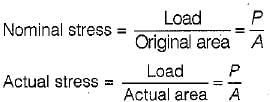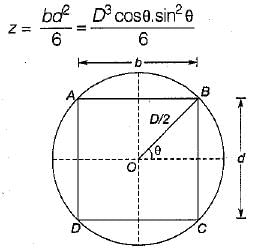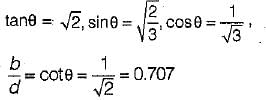Civil Engineering (CE) Exam > Civil Engineering (CE) Tests > GATE Civil Engineering (CE) 2026 Mock Test Series > Test: Properties of Metals, Simple Stress Strain & Elastic Constants - 1 - Civil Engineering (CE) MCQ
Test: Properties of Metals, Simple Stress Strain & Elastic Constants - 1 - Civil Engineering (CE) MCQ
Test Description
10 Questions MCQ Test GATE Civil Engineering (CE) 2026 Mock Test Series - Test: Properties of Metals, Simple Stress Strain & Elastic Constants - 1
Test: Properties of Metals, Simple Stress Strain & Elastic Constants - 1 for Civil Engineering (CE) 2025 is part of GATE Civil Engineering (CE) 2026 Mock Test Series preparation. The Test: Properties of Metals, Simple Stress Strain & Elastic Constants - 1 questions and answers have been
prepared according to the Civil Engineering (CE) exam syllabus.The Test: Properties of Metals, Simple Stress Strain & Elastic Constants - 1 MCQs are made for Civil Engineering (CE) 2025 Exam. Find important
definitions, questions, notes, meanings, examples, exercises, MCQs and online tests for Test: Properties of Metals, Simple Stress Strain & Elastic Constants - 1 below.
Solutions of Test: Properties of Metals, Simple Stress Strain & Elastic Constants - 1 questions in English are available as part of our GATE Civil Engineering (CE) 2026 Mock Test Series for Civil Engineering (CE) & Test: Properties of Metals, Simple Stress Strain & Elastic Constants - 1 solutions in
Hindi for GATE Civil Engineering (CE) 2026 Mock Test Series course. Download more important topics, notes, lectures and mock
test series for Civil Engineering (CE) Exam by signing up for free. Attempt Test: Properties of Metals, Simple Stress Strain & Elastic Constants - 1 | 10 questions in 30 minutes | Mock test for Civil Engineering (CE) preparation | Free important questions MCQ to study GATE Civil Engineering (CE) 2026 Mock Test Series for Civil Engineering (CE) Exam | Download free PDF with solutions
Test: Properties of Metals, Simple Stress Strain & Elastic Constants - 1 - Question 1
A material has identical properties in all directions, it is said to be
Detailed Solution for Test: Properties of Metals, Simple Stress Strain & Elastic Constants - 1 - Question 1
Test: Properties of Metals, Simple Stress Strain & Elastic Constants - 1 - Question 2
The term nominal stress in stress-strain curve for mild steel implies
Detailed Solution for Test: Properties of Metals, Simple Stress Strain & Elastic Constants - 1 - Question 2
Test: Properties of Metals, Simple Stress Strain & Elastic Constants - 1 - Question 3
For metallic minerals creep becomes an important consideration at
Detailed Solution for Test: Properties of Metals, Simple Stress Strain & Elastic Constants - 1 - Question 3
Test: Properties of Metals, Simple Stress Strain & Elastic Constants - 1 - Question 4
Clapeyron's theorem is associated with the analysis of
Detailed Solution for Test: Properties of Metals, Simple Stress Strain & Elastic Constants - 1 - Question 4
Test: Properties of Metals, Simple Stress Strain & Elastic Constants - 1 - Question 5
A rubber band is elongated to double its initial length, its true strain is
Detailed Solution for Test: Properties of Metals, Simple Stress Strain & Elastic Constants - 1 - Question 5
Test: Properties of Metals, Simple Stress Strain & Elastic Constants - 1 - Question 6
A prismatic beam has uniform
Detailed Solution for Test: Properties of Metals, Simple Stress Strain & Elastic Constants - 1 - Question 6
Test: Properties of Metals, Simple Stress Strain & Elastic Constants - 1 - Question 7
In the case of pure bending, the beam will bend into an arc of a
Detailed Solution for Test: Properties of Metals, Simple Stress Strain & Elastic Constants - 1 - Question 7
Test: Properties of Metals, Simple Stress Strain & Elastic Constants - 1 - Question 8
If the modulus of elasticity is zero, the material is said to be
Detailed Solution for Test: Properties of Metals, Simple Stress Strain & Elastic Constants - 1 - Question 8
Test: Properties of Metals, Simple Stress Strain & Elastic Constants - 1 - Question 9
The compressibility of a material is proportional to
Detailed Solution for Test: Properties of Metals, Simple Stress Strain & Elastic Constants - 1 - Question 9
Test: Properties of Metals, Simple Stress Strain & Elastic Constants - 1 - Question 10
If a beam with the rectangular cross-section is obtained by cutting from circular log of timber, then for the beam to have strongest section in bending, the ratio of breadth to depth should be
Detailed Solution for Test: Properties of Metals, Simple Stress Strain & Elastic Constants - 1 - Question 10
|
31 docs|280 tests
|
Information about Test: Properties of Metals, Simple Stress Strain & Elastic Constants - 1 Page
In this test you can find the Exam questions for Test: Properties of Metals, Simple Stress Strain & Elastic Constants - 1 solved & explained in the simplest way possible.
Besides giving Questions and answers for Test: Properties of Metals, Simple Stress Strain & Elastic Constants - 1, EduRev gives you an ample number of Online tests for practice





























